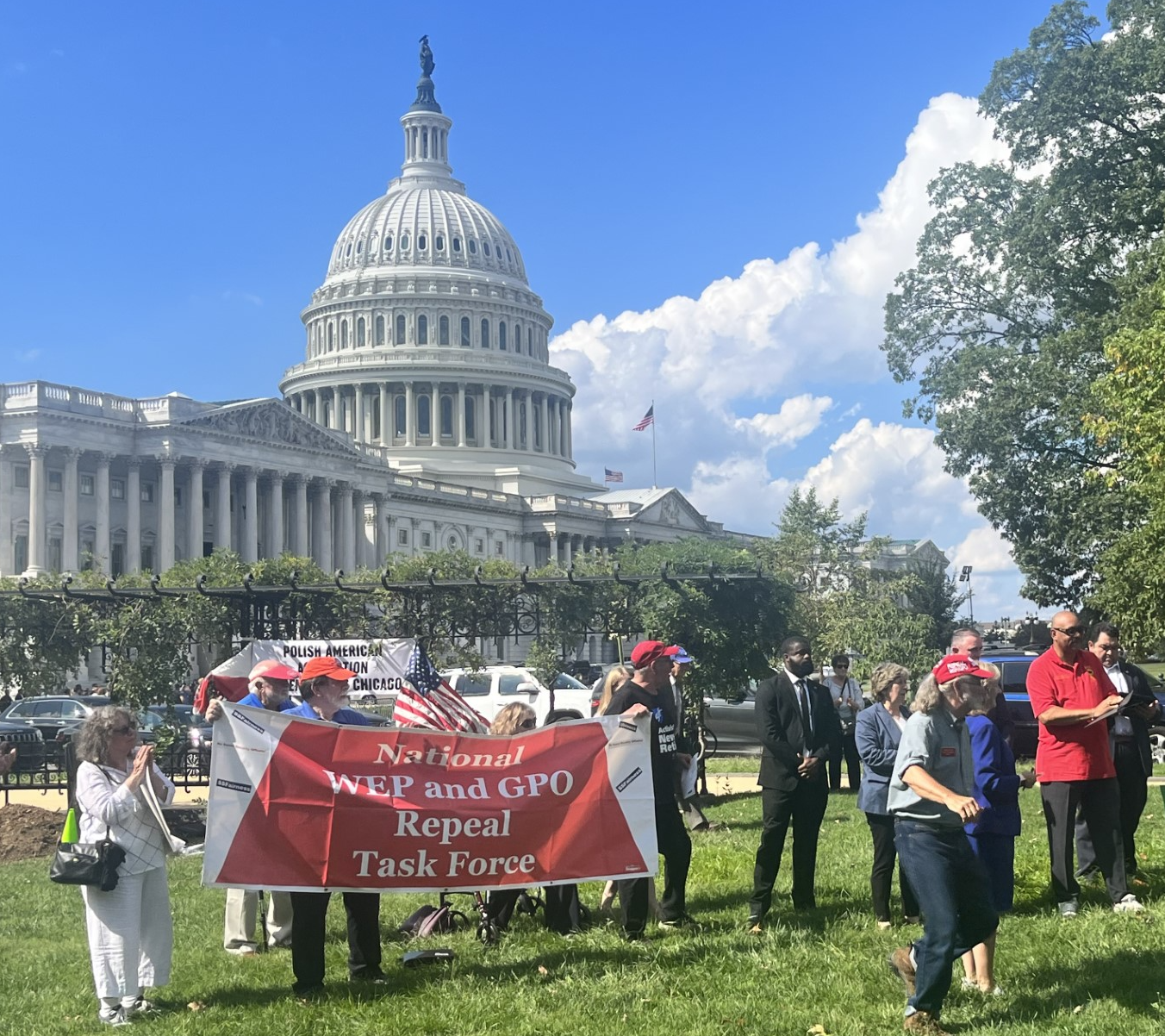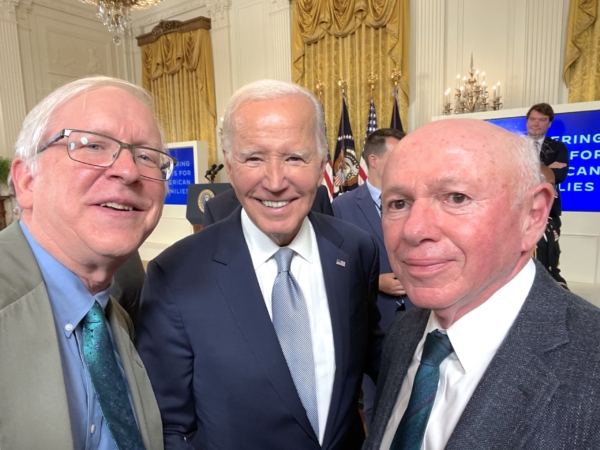It’s Time to Repeal WEP & GPO, Says NCPSSM & National Task Force
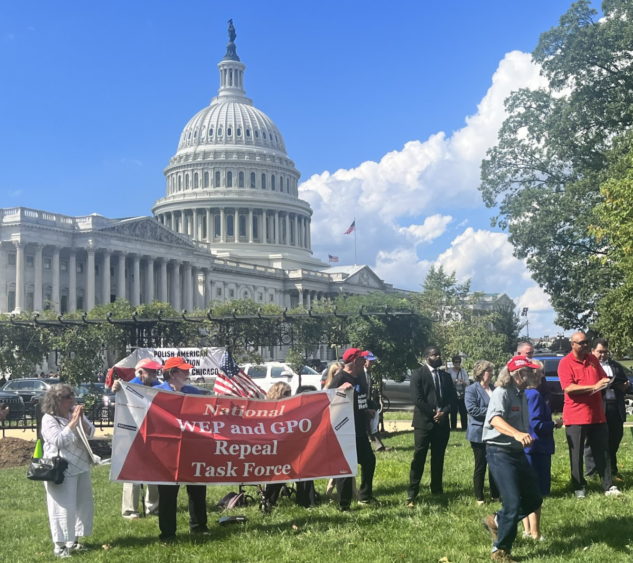
NCPSSM participated in an event on the Capitol Grounds Wednesday to call for the repeal of the Windfall Elimination Provision (WEP) and Government Pension Offset (GPO), which prevent millions of public employees and their families from collecting full Social Security benefits. The event was organized by the National WEP/GPO Repeal Task Force — a coalition of advocates representing public sector workers.
Congress created the GPO in 1977 to help ensure that spousal and widow(er) benefits of those with covered or non-covered lifetime earnings would be roughly equal. The Windfall Elimination Provision (WEP), enacted in 1983, reduces the Social Security benefits of workers who receive pensions from a federal, state, or local government for employment not covered by Social Security.
Advocates argue that these provisions – originally intended to make Social Security benefits fairer – actually penalize public sector employees like teachers, firefighters, police officers, and federal workers.
“In enacting the WEP and GPO, Congress created a completely different set of inequities, slashing Social Security benefits for some even though their payroll contributions might be exactly the same as their fellow Americans whose work history was entirely within the Social Security system,” said NCPSSM President Max Richtman at the Wednesday event.
The WEP and GPO, Richtman said, leaves millions of retirees and their families with little or no Social Security benefits, despite decades of contributions in payroll taxes.
NCPSSM has endorsed legislation favored by the National WEP/GPO Repeal Task Force, the Social Security Fairness Act:
The bill eliminates the government pension offset, which in various instances reduces Social Security benefits for spouses, widows, and widowers who also receive government pensions of their own.
The bill also eliminates the windfall elimination provision, which in some instances reduces Social Security benefits for individuals who also receive a pension or disability benefit from an employer that did not withhold Social Security taxes.
The National WEP/GPO Repeal Task Force is leading a grassroots movement to spur Congress to enact the Social Security Fairness Act. “This is a serious issue that’s gone on way too long,” said Suzie Dixon, President of the California Retired Teachers Association and vice-chair of the task force. “It is time to let teachers, firefighters, police officers and other public sector employees live their senior years in dignity.”
NCPSSM also strongly endorses Rep. John Larson’s Social Security 2100 Act, which would repeal the WEP & GPO in addition to strengthening the program’s finances and boosting retirees’ benefits.
NCPSSM To Participate in Harkin Social Security Symposium in DC



The Harkin Institute’s Director of Retirement Security, Rayna Stoycheva, says the symposium, Preserving and Enhancing Social Security for All, comes at a crucial time for Social Security. “In the last couple of years, there has been an uptick in legislative proposals focused on balancing the trust fund and enhancing the Social Security program,” says Stoycheva. “We thought that a symposium that focuses on the program in more detail was timely — and would serve our mission to connect citizens with the policy making process.”
For the National Committee to Preserve Social Security and Medicare, the exchange of ideas with other advocates is crucial to its mission. “Senator Harkin is the chair of our advisory board and a true champion of Social Security, so we are especially honored to have a role in this symposium,” says Richtman.
“We applaud the Harkin Institute for bringing together so many thought leaders in this field at a time when Social Security faces considerable financial and political challenges. Events like this are crucial to ensure that the program is protected and expanded rather than cut and privatized, as some in Washington have proposed.” – Max Richtman, NCPSSM President and CEO
The keynote speakers for the symposium are Stephen Goss, Chief Actuary at the Social Security Administration and Rep. John Larson (D-CT), author of the Social Security 2100 Act to protect and expand the program.



Social Security Chief Actuary Stephen Goss & Rep. John Larson are keynote speakers
Registration is now open for up to 200 attendees. The intended audience for the symposium is: policymakers, researchers, practitioners, and retirement security professionals. “Anyone dedicated to improving retirement security and reducing poverty and inequality will find value in this symposium,” says Stoycheva. “The event will lay out what options we can consider in the coming years to achieve the mission of preserving Social Security.”
Specifically, the symposium will shed light on some important questions, including:
How has the Social Security program evolved over the years?
What role does it play for retirement security in the current retirement system?
What are the distributional effects of different proposals?
What is the outlook for specific legislative action in the next 10 years?
NCPSSM President Richtman will lead a panel entitled, “Public Opinion on Social Security Reform and Legislative Agenda,” featuring several speakers including Nancy LeaMond, Executive Vice President and Chief Advocacy & Engagement Officer at AARP.
Other VIP panelists at the symposium include: William Arnone (NASI), Rich Fiesta (Alliance for Retirement Americans), Monique Morrissey (Economic Policy Institute), Kathleen Romig (CBPP), Teresa Ghilarducci (New School for Social Research), Jeff Cruz (AFGE), Rebecca Vallas (Century Foundation), and Nancy Altman (Social Security Works).
“This is an amazing group of policy leaders in this space!” says Stoycheva. “Putting together the program has truly been a collaborative effort involving many different people.” Stoycheva credits, in particular, Alicia Munnell of the Center for Retirement Research at Boston College and William Arnone (Executive Director at the National Academy of Social Insurance) for helping put the program together, with additional input from Richtman and Social Security Works president, Nancy Altman.
There still is time to register for the symposium at: https://harkininstitute.drake.edu/2023/07/19/2023-harkin-retirement-security-symposium/
“There are still some spaces left,” says Stoycheva. “We encourage anyone in this field with a stake in the future of Social Security to avail themselves of this opportunity.”
NCPSSM At White House for Release of First Ten Drugs for Medicare Price Negotiation
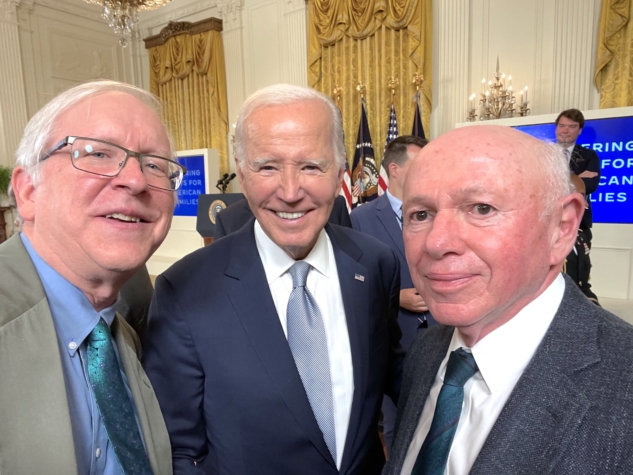


NCPSSM President Max Richtman and Policy Director Dan Adcock were at the White House Tuesday as the Biden administration released the names of the first ten drugs to be subject to price negotiation between Medicare and Big Pharma. They are some of the most common and most expensive prescription medications that seniors take. These essential medications do everything from preventing blood clots and strokes to treating diabetes, and they will soon cost a lot less for the federal government and for patients.
“This is a sea change in the government’s ability to lower prescription drug prices for older Americans, who all too often are compelled to ration medications or forgo filling prescriptions because of soaring costs.” – Max Richtman, NCPSSM President & CEO, 8/29/23
The Inflation Reduction Act of 2022 empowered Medicare to begin negotiating prices for targeted prescription drugs, something advocates including NCPSSM have struggled to achieve for more than twenty years. Here is a list of the first ten drugs that will be subject to price negotiation with Medicare:
- Eliquis, for preventing strokes and blood clots
- Jardiance, for diabetes and heart failure
- Xarelto,for preventing strokes and blood clots
- Januvia, for diabetes
- Farxiga, for diabetes, heart failure and chronic kidney disease
- Entresto, for heart failure
- Enbrel, for arthritis and other autoimmune conditions
- Imbruvica, for blood cancers
- Stelara, for Crohn’s disease
- Fiasp andNovoLog insulin products for diabetes
Drugmakers made a whopping $493 billion in revenue from these ten drugs, which have accounted for more than $170 billion in gross Medicare spending, according to a report from the nonprofit, Protect Our Care.
President Biden hailed the release of the first ten medications for negotiation as a victory for everyday Americans, who have been subject to price gouging by the drug industry. “There is no reason why Americans should be forced to pay more than any developed nation for life-saving prescriptions just to pad Big Pharma’s pockets,” he said
According to the White House, the 9 million seniors who take the ten targeted drugs will see their costs decrease. These seniors currently pay up to $6,500 in out-of-pocket costs per year for these prescriptions. The nonpartisan Congressional Budget Office reports that this will save taxpayers $160 billion by reducing how much Medicare pays for drugs through negotiation and inflation rebates.
The seniors who have been victimized by price gouging and now will finally get some relief are front of mind for advocates, including Patients for Affordable Drugs Now. The group quotes a Medicare beneficiary in North Carolina who lives with a rare cancer and type 2 diabetes:
“To treat my diabetes, I take Januvia, which carries a monthly list price of $547. Drugmaker Merck has made a fortune from patients like me who are forced to pay whatever price the company dictates. A fairer price for Januvia will mean a world of difference.” – Steven Hadfield, Matthews, NC
The list of drugs subject to negotiation will expand next year to 15, followed by another 15 medications the year after. Negotiated prices for the first ten drugs do not go into effect until 2026.
NCPSSM’s senior health policy expert, Anne Montgomery, says the Biden administration (HHS & CMS) did a “savvy job” of selecting the first set of drugs for negotiation because they are “ten of the highest cost and most commonly used medications” among seniors. “That’s very smart,” she says, “as a way of building a constituency among beneficiaries for the movement to lower drug prices.”
Several drugmakers are suing the Biden administration, claiming that Medicare drug price negotiation is unconstitutional — despite the fact that the V.A. has been successfully negotiating drug prices with Big Pharma for years. Administration officials say that they believe the drug companies have a weak case and will not prevail.
Advocates like NCPSSM are not resting with the implementation of the Inflation Reduction Act’s drug provisions. “The next step is to enlarge the number and type of medications subject to negotiation, to deliver maximum relief to seniors on fixed incomes,” says Richtman. “No one should have to choose between groceries, rent, or essential medications — especially our nation’s senior citizens.”
FDR’S Grandson Says This Is a ‘High Stakes Time’ For Social Security



By James Roosevelt, Jr.
Social Security — which turned 88 years old in August — is one of my grandfather’s greatest legacies. It’s no exaggeration to say that this is a high stakes time for his landmark program. Powerful opponents of Social Security are calling for privatization, cutting the annual COLA, raising the retirement age, and even “sunsetting” the program. That’s not something I could bear to see. Not at a time when so many Americans are counting on their earned benefits to make ends meet.
Yet, every time there is talk about reining in budget deficits, many politicians turn to Social Security. It’s always been an easy target for so-called “deficit hawks” in Washington who would much rather chip away at seniors’ earned benefits than reverse decades of unfair (and unpaid for!) tax policies that benefit wealthy Americans and huge corporations.
Fortunately, my grandfather helped structure the Social Security program to make it hard to cut or privatize Social Security. Because Social Security has its own dedicated income stream from the payroll tax, we don’t just trade it off against education or defense or other important priorities.
My grandfather famously said, “With those taxes in there, no damn politician can ever scrap my Social Security program.”
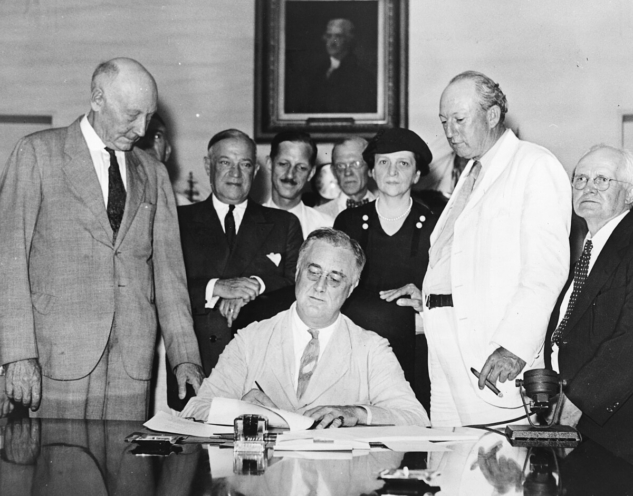


President Franklin D. Roosevelt signs Social Security into law (August 14, 1935)
But today hardliners in Congress are closer than ever to defunding this critical program that provides 66 million Americans and their families with basic financial security upon retirement or disability. The program has never missed a payment — even during war, recessions and a pandemic. And yet, I’m hearing more politicians than ever talking about the need to change, cut, scale back and even end Social Security “for the good of the economy.”
*Senator Rick Scott (R-FL) proposed a plan where Social Security would have to be reauthorized by Congress every five years.
*Senator Ron Johnson (R-WI) said that Social Security spending should be considered “discretionary spending” and subject to routine budget negotiations every year, even though the program is self-funded by workers.
*Other politicians, including potential 2024 presidential candidates, are calling for raising the retirement age to 70. While that may work out just fine for a lawyer or Wall Street broker, raising the retirement age would have the harshest impact on people working in physically demanding jobs.
*Former Vice President Mike Pence, a 2024 presidential candidate, is now calling for major reforms to Social Security, including privatization. And he recently said, “I think we can replace the New Deal programs with a better deal.”
As a reminder, in 2005, the National Committee helped lead intense grassroots activism against former President George W. Bush’s serious attempt to privatize Social Security. (Congressman Mike Pence was involved in that effort). If President Bush had succeeded, his plan would have handed over control of Social Security benefits to Wall Street brokers and subjected the earned benefits of millions of older Americans to the volatility of the Stock Market.



James Roosevelt, Jr., grandson of FDR & vice-chair of NCPSSM Advisory Board
Lawmakers pushing these dangerous and callous proposals are missing an important point: We can’t just change or cut Social Security without risking the livelihoods of millions of retirees. The real power to protect Social Security lies with us. When we stand shoulder-to-shoulder with millions of senior voters — Congress not only listens, it often reacts in our favor.
James Roosevelt, Jr. is the grandson of President Franklin D. Roosevelt, and son of NCPSSM’s founder, Congressman James Roosevelt, Sr. He is vice-chair of NCPSSM’s Advisory Board and served as CEO of Tufts Health Plan. Previously, he served as Associate Commissioner of the U.S. Social Security Administration.
Marking the First Anniversary of the Inflation Reduction Act
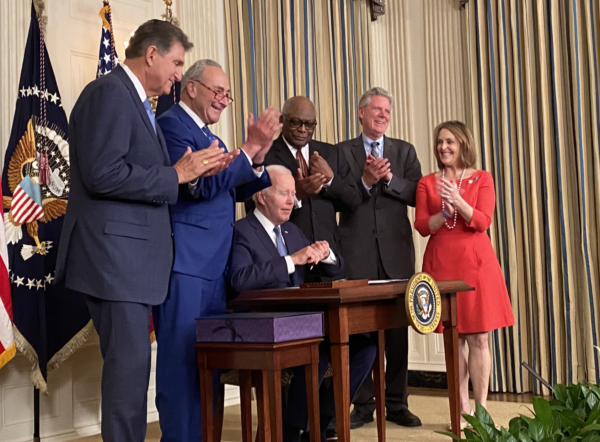


President Biden signed the historic Inflation Reduction Act (IRA) into law one year ago today. It was the first time Congress enacted major legislation to take on Big Pharma and lower the price of prescription drugs for seniors. For us, the IRA was the culmination of a 20 year struggle to reform Medicare Part D — the prescription drug benefit — so that seniors actually could afford crucial medications. We had seen too many statistics over the years about older Americans cutting pills in half or not filling prescriptions because of high costs — or having to choose between essentials like food and medicine.
“We took on Big Pharma, and we won,” proclaimed President Biden after the IRA was enacted. Though the IRA cannot solve the entire drug pricing problem, it will provide relief to millions of American seniors. Here are its major provisions:
*Empowers Medicare to negotiate prices with drug-makers
*Caps Medicare Part D patients’ annual out-of-pocket payments at $2,000
*Caps the cost of insulin for Part D patients at $35/month
*Penalizes drug-makers for raising prices above the rate of inflation
The IRA’s most historic aspect is the drug price negotiation provision – more modest than originally envisioned, but still extremely significant. At first, only ten drugs will be eligible for negotiations, and new brand-name drugs are excluded. Negotiated prices will not take effect until 2026. But Big Pharma opposed these relatively modest measures, and is currently trying to block them in court.
Undaunted, the Biden administration has been spending the past year fleshing out rules for implementing the Inflation Reduction Act’s drug pricing provisions.
“Starting this year, Medicare will begin to negotiate directly with drug manufacturers to bring down the price of covered high-cost prescription drugs. CMS will announce the first 10 drugs selected for negotiation by September 1, 2023. The first round of negotiations will occur during 2023 and 2024. The prices that are negotiated will be effective starting in 2026.” – Center for Medicare & Medicaid Services, 6/30/23
In March, CMS released initial guidance on the drug price negotiation process, outlining “how the agency will select drugs for negotiation this year and how those negotiations will be conducted.” At the end of June, CMS released a revised framework, “informed by public input,” for how the government will negotiate with drugmakers on a maximum fair price for selected drugs. This, the agency says, will ensure “that Medicare beneficiaries have access to innovative, life-saving treatments” at a lower cost for patients and for the Medicare program itself.
On July 1st, the Inflation Reduction Act’s cap on insulin costs for Medicare patients went into effect. Beneficiaries will pay no more than $35/month for insulin. Insulin prices had soared nearly 40% from 2014-2018, and patients’ out-of-pocket costs were running from $300 to $1,000 per month. Over the years, we heard heartbreaking stories about diabetics who rationed insulin because of the high cost and ended up gravely ill or dead. In addition to lowering prices, the Inflation Reduction Act can truly be a lifesaver.
The IRA’s cap on out-of-pocket drug costs for Medicare Part D beneficiaries is especially crucial for patients with serious chronic conditions like cancer or multiple sclerosis. As Kaiser Family Foundation reported, out-of-pocket costs for medications to treat those conditions can be staggering – especially for seniors on fixed incomes:
“For example, in 2020, among Part D enrollees without low-income subsidies, average annual out-of-pocket spending for the cancer drug Revlimid was $6,200 $5,700 for the cancer drug Imbruvica; and $4,100 for the MS drug Avonex.” – Kaiser Family Foundation, 1/24/23
Seniors without subsidies will have to continue paying those higher prices until 2025, when the $2,000 out-of-pocket cap takes effect.
The Inflation Reduction Act was an ambitious, wide-ranging piece of legislation that included not only prescription drug pricing reform, but climate change mitigation and measures to make the U.S. more economically competitive in the 21st century.
Not all Americans, let alone, seniors are aware of the historic drug pricing reforms in the Inflation Reduction Act. The Biden administration has been working to enhance the public’s understanding of the law’s positive impact on their pocketbooks and overall health. CMS posts updates on its activities here. And HHS’ Office of the Assistant Secretary for Planning & Evaluation (ASPE) has a great informational resource on prescription drug price reform, as well.
Meanwhile, the National Committee to Preserve Social Security and Medicare, which tirelessly advocated for the prescription drug reforms in the IRA, will continue to keep the pressure on Congress to lower prices for seniors and all Americans.
“We want the number and types of drugs subject to negotiation to be broadened. Eventually we would like to see all drugs subject to Medicare price negotiation,” said NCPSSM legislative director, Dan Adcock. “The door has been opened. Now it’s our job to keep pushing it ever wider so that older Americans can afford the drugs they need to save their lives — and have a better quality of life.”
It’s Time to Repeal WEP & GPO, Says NCPSSM & National Task Force



NCPSSM participated in an event on the Capitol Grounds Wednesday to call for the repeal of the Windfall Elimination Provision (WEP) and Government Pension Offset (GPO), which prevent millions of public employees and their families from collecting full Social Security benefits. The event was organized by the National WEP/GPO Repeal Task Force — a coalition of advocates representing public sector workers.
Congress created the GPO in 1977 to help ensure that spousal and widow(er) benefits of those with covered or non-covered lifetime earnings would be roughly equal. The Windfall Elimination Provision (WEP), enacted in 1983, reduces the Social Security benefits of workers who receive pensions from a federal, state, or local government for employment not covered by Social Security.
Advocates argue that these provisions – originally intended to make Social Security benefits fairer – actually penalize public sector employees like teachers, firefighters, police officers, and federal workers.
“In enacting the WEP and GPO, Congress created a completely different set of inequities, slashing Social Security benefits for some even though their payroll contributions might be exactly the same as their fellow Americans whose work history was entirely within the Social Security system,” said NCPSSM President Max Richtman at the Wednesday event.
The WEP and GPO, Richtman said, leaves millions of retirees and their families with little or no Social Security benefits, despite decades of contributions in payroll taxes.
NCPSSM has endorsed legislation favored by the National WEP/GPO Repeal Task Force, the Social Security Fairness Act:
The bill eliminates the government pension offset, which in various instances reduces Social Security benefits for spouses, widows, and widowers who also receive government pensions of their own.
The bill also eliminates the windfall elimination provision, which in some instances reduces Social Security benefits for individuals who also receive a pension or disability benefit from an employer that did not withhold Social Security taxes.
The National WEP/GPO Repeal Task Force is leading a grassroots movement to spur Congress to enact the Social Security Fairness Act. “This is a serious issue that’s gone on way too long,” said Suzie Dixon, President of the California Retired Teachers Association and vice-chair of the task force. “It is time to let teachers, firefighters, police officers and other public sector employees live their senior years in dignity.”
NCPSSM also strongly endorses Rep. John Larson’s Social Security 2100 Act, which would repeal the WEP & GPO in addition to strengthening the program’s finances and boosting retirees’ benefits.
NCPSSM To Participate in Harkin Social Security Symposium in DC



The Harkin Institute’s Director of Retirement Security, Rayna Stoycheva, says the symposium, Preserving and Enhancing Social Security for All, comes at a crucial time for Social Security. “In the last couple of years, there has been an uptick in legislative proposals focused on balancing the trust fund and enhancing the Social Security program,” says Stoycheva. “We thought that a symposium that focuses on the program in more detail was timely — and would serve our mission to connect citizens with the policy making process.”
For the National Committee to Preserve Social Security and Medicare, the exchange of ideas with other advocates is crucial to its mission. “Senator Harkin is the chair of our advisory board and a true champion of Social Security, so we are especially honored to have a role in this symposium,” says Richtman.
“We applaud the Harkin Institute for bringing together so many thought leaders in this field at a time when Social Security faces considerable financial and political challenges. Events like this are crucial to ensure that the program is protected and expanded rather than cut and privatized, as some in Washington have proposed.” – Max Richtman, NCPSSM President and CEO
The keynote speakers for the symposium are Stephen Goss, Chief Actuary at the Social Security Administration and Rep. John Larson (D-CT), author of the Social Security 2100 Act to protect and expand the program.



Social Security Chief Actuary Stephen Goss & Rep. John Larson are keynote speakers
Registration is now open for up to 200 attendees. The intended audience for the symposium is: policymakers, researchers, practitioners, and retirement security professionals. “Anyone dedicated to improving retirement security and reducing poverty and inequality will find value in this symposium,” says Stoycheva. “The event will lay out what options we can consider in the coming years to achieve the mission of preserving Social Security.”
Specifically, the symposium will shed light on some important questions, including:
How has the Social Security program evolved over the years?
What role does it play for retirement security in the current retirement system?
What are the distributional effects of different proposals?
What is the outlook for specific legislative action in the next 10 years?
NCPSSM President Richtman will lead a panel entitled, “Public Opinion on Social Security Reform and Legislative Agenda,” featuring several speakers including Nancy LeaMond, Executive Vice President and Chief Advocacy & Engagement Officer at AARP.
Other VIP panelists at the symposium include: William Arnone (NASI), Rich Fiesta (Alliance for Retirement Americans), Monique Morrissey (Economic Policy Institute), Kathleen Romig (CBPP), Teresa Ghilarducci (New School for Social Research), Jeff Cruz (AFGE), Rebecca Vallas (Century Foundation), and Nancy Altman (Social Security Works).
“This is an amazing group of policy leaders in this space!” says Stoycheva. “Putting together the program has truly been a collaborative effort involving many different people.” Stoycheva credits, in particular, Alicia Munnell of the Center for Retirement Research at Boston College and William Arnone (Executive Director at the National Academy of Social Insurance) for helping put the program together, with additional input from Richtman and Social Security Works president, Nancy Altman.
There still is time to register for the symposium at: https://harkininstitute.drake.edu/2023/07/19/2023-harkin-retirement-security-symposium/
“There are still some spaces left,” says Stoycheva. “We encourage anyone in this field with a stake in the future of Social Security to avail themselves of this opportunity.”
NCPSSM At White House for Release of First Ten Drugs for Medicare Price Negotiation



NCPSSM President Max Richtman and Policy Director Dan Adcock were at the White House Tuesday as the Biden administration released the names of the first ten drugs to be subject to price negotiation between Medicare and Big Pharma. They are some of the most common and most expensive prescription medications that seniors take. These essential medications do everything from preventing blood clots and strokes to treating diabetes, and they will soon cost a lot less for the federal government and for patients.
“This is a sea change in the government’s ability to lower prescription drug prices for older Americans, who all too often are compelled to ration medications or forgo filling prescriptions because of soaring costs.” – Max Richtman, NCPSSM President & CEO, 8/29/23
The Inflation Reduction Act of 2022 empowered Medicare to begin negotiating prices for targeted prescription drugs, something advocates including NCPSSM have struggled to achieve for more than twenty years. Here is a list of the first ten drugs that will be subject to price negotiation with Medicare:
- Eliquis, for preventing strokes and blood clots
- Jardiance, for diabetes and heart failure
- Xarelto,for preventing strokes and blood clots
- Januvia, for diabetes
- Farxiga, for diabetes, heart failure and chronic kidney disease
- Entresto, for heart failure
- Enbrel, for arthritis and other autoimmune conditions
- Imbruvica, for blood cancers
- Stelara, for Crohn’s disease
- Fiasp andNovoLog insulin products for diabetes
Drugmakers made a whopping $493 billion in revenue from these ten drugs, which have accounted for more than $170 billion in gross Medicare spending, according to a report from the nonprofit, Protect Our Care.
President Biden hailed the release of the first ten medications for negotiation as a victory for everyday Americans, who have been subject to price gouging by the drug industry. “There is no reason why Americans should be forced to pay more than any developed nation for life-saving prescriptions just to pad Big Pharma’s pockets,” he said
According to the White House, the 9 million seniors who take the ten targeted drugs will see their costs decrease. These seniors currently pay up to $6,500 in out-of-pocket costs per year for these prescriptions. The nonpartisan Congressional Budget Office reports that this will save taxpayers $160 billion by reducing how much Medicare pays for drugs through negotiation and inflation rebates.
The seniors who have been victimized by price gouging and now will finally get some relief are front of mind for advocates, including Patients for Affordable Drugs Now. The group quotes a Medicare beneficiary in North Carolina who lives with a rare cancer and type 2 diabetes:
“To treat my diabetes, I take Januvia, which carries a monthly list price of $547. Drugmaker Merck has made a fortune from patients like me who are forced to pay whatever price the company dictates. A fairer price for Januvia will mean a world of difference.” – Steven Hadfield, Matthews, NC
The list of drugs subject to negotiation will expand next year to 15, followed by another 15 medications the year after. Negotiated prices for the first ten drugs do not go into effect until 2026.
NCPSSM’s senior health policy expert, Anne Montgomery, says the Biden administration (HHS & CMS) did a “savvy job” of selecting the first set of drugs for negotiation because they are “ten of the highest cost and most commonly used medications” among seniors. “That’s very smart,” she says, “as a way of building a constituency among beneficiaries for the movement to lower drug prices.”
Several drugmakers are suing the Biden administration, claiming that Medicare drug price negotiation is unconstitutional — despite the fact that the V.A. has been successfully negotiating drug prices with Big Pharma for years. Administration officials say that they believe the drug companies have a weak case and will not prevail.
Advocates like NCPSSM are not resting with the implementation of the Inflation Reduction Act’s drug provisions. “The next step is to enlarge the number and type of medications subject to negotiation, to deliver maximum relief to seniors on fixed incomes,” says Richtman. “No one should have to choose between groceries, rent, or essential medications — especially our nation’s senior citizens.”
FDR’S Grandson Says This Is a ‘High Stakes Time’ For Social Security



By James Roosevelt, Jr.
Social Security — which turned 88 years old in August — is one of my grandfather’s greatest legacies. It’s no exaggeration to say that this is a high stakes time for his landmark program. Powerful opponents of Social Security are calling for privatization, cutting the annual COLA, raising the retirement age, and even “sunsetting” the program. That’s not something I could bear to see. Not at a time when so many Americans are counting on their earned benefits to make ends meet.
Yet, every time there is talk about reining in budget deficits, many politicians turn to Social Security. It’s always been an easy target for so-called “deficit hawks” in Washington who would much rather chip away at seniors’ earned benefits than reverse decades of unfair (and unpaid for!) tax policies that benefit wealthy Americans and huge corporations.
Fortunately, my grandfather helped structure the Social Security program to make it hard to cut or privatize Social Security. Because Social Security has its own dedicated income stream from the payroll tax, we don’t just trade it off against education or defense or other important priorities.
My grandfather famously said, “With those taxes in there, no damn politician can ever scrap my Social Security program.”



President Franklin D. Roosevelt signs Social Security into law (August 14, 1935)
But today hardliners in Congress are closer than ever to defunding this critical program that provides 66 million Americans and their families with basic financial security upon retirement or disability. The program has never missed a payment — even during war, recessions and a pandemic. And yet, I’m hearing more politicians than ever talking about the need to change, cut, scale back and even end Social Security “for the good of the economy.”
*Senator Rick Scott (R-FL) proposed a plan where Social Security would have to be reauthorized by Congress every five years.
*Senator Ron Johnson (R-WI) said that Social Security spending should be considered “discretionary spending” and subject to routine budget negotiations every year, even though the program is self-funded by workers.
*Other politicians, including potential 2024 presidential candidates, are calling for raising the retirement age to 70. While that may work out just fine for a lawyer or Wall Street broker, raising the retirement age would have the harshest impact on people working in physically demanding jobs.
*Former Vice President Mike Pence, a 2024 presidential candidate, is now calling for major reforms to Social Security, including privatization. And he recently said, “I think we can replace the New Deal programs with a better deal.”
As a reminder, in 2005, the National Committee helped lead intense grassroots activism against former President George W. Bush’s serious attempt to privatize Social Security. (Congressman Mike Pence was involved in that effort). If President Bush had succeeded, his plan would have handed over control of Social Security benefits to Wall Street brokers and subjected the earned benefits of millions of older Americans to the volatility of the Stock Market.



James Roosevelt, Jr., grandson of FDR & vice-chair of NCPSSM Advisory Board
Lawmakers pushing these dangerous and callous proposals are missing an important point: We can’t just change or cut Social Security without risking the livelihoods of millions of retirees. The real power to protect Social Security lies with us. When we stand shoulder-to-shoulder with millions of senior voters — Congress not only listens, it often reacts in our favor.
James Roosevelt, Jr. is the grandson of President Franklin D. Roosevelt, and son of NCPSSM’s founder, Congressman James Roosevelt, Sr. He is vice-chair of NCPSSM’s Advisory Board and served as CEO of Tufts Health Plan. Previously, he served as Associate Commissioner of the U.S. Social Security Administration.
Marking the First Anniversary of the Inflation Reduction Act



President Biden signed the historic Inflation Reduction Act (IRA) into law one year ago today. It was the first time Congress enacted major legislation to take on Big Pharma and lower the price of prescription drugs for seniors. For us, the IRA was the culmination of a 20 year struggle to reform Medicare Part D — the prescription drug benefit — so that seniors actually could afford crucial medications. We had seen too many statistics over the years about older Americans cutting pills in half or not filling prescriptions because of high costs — or having to choose between essentials like food and medicine.
“We took on Big Pharma, and we won,” proclaimed President Biden after the IRA was enacted. Though the IRA cannot solve the entire drug pricing problem, it will provide relief to millions of American seniors. Here are its major provisions:
*Empowers Medicare to negotiate prices with drug-makers
*Caps Medicare Part D patients’ annual out-of-pocket payments at $2,000
*Caps the cost of insulin for Part D patients at $35/month
*Penalizes drug-makers for raising prices above the rate of inflation
The IRA’s most historic aspect is the drug price negotiation provision – more modest than originally envisioned, but still extremely significant. At first, only ten drugs will be eligible for negotiations, and new brand-name drugs are excluded. Negotiated prices will not take effect until 2026. But Big Pharma opposed these relatively modest measures, and is currently trying to block them in court.
Undaunted, the Biden administration has been spending the past year fleshing out rules for implementing the Inflation Reduction Act’s drug pricing provisions.
“Starting this year, Medicare will begin to negotiate directly with drug manufacturers to bring down the price of covered high-cost prescription drugs. CMS will announce the first 10 drugs selected for negotiation by September 1, 2023. The first round of negotiations will occur during 2023 and 2024. The prices that are negotiated will be effective starting in 2026.” – Center for Medicare & Medicaid Services, 6/30/23
In March, CMS released initial guidance on the drug price negotiation process, outlining “how the agency will select drugs for negotiation this year and how those negotiations will be conducted.” At the end of June, CMS released a revised framework, “informed by public input,” for how the government will negotiate with drugmakers on a maximum fair price for selected drugs. This, the agency says, will ensure “that Medicare beneficiaries have access to innovative, life-saving treatments” at a lower cost for patients and for the Medicare program itself.
On July 1st, the Inflation Reduction Act’s cap on insulin costs for Medicare patients went into effect. Beneficiaries will pay no more than $35/month for insulin. Insulin prices had soared nearly 40% from 2014-2018, and patients’ out-of-pocket costs were running from $300 to $1,000 per month. Over the years, we heard heartbreaking stories about diabetics who rationed insulin because of the high cost and ended up gravely ill or dead. In addition to lowering prices, the Inflation Reduction Act can truly be a lifesaver.
The IRA’s cap on out-of-pocket drug costs for Medicare Part D beneficiaries is especially crucial for patients with serious chronic conditions like cancer or multiple sclerosis. As Kaiser Family Foundation reported, out-of-pocket costs for medications to treat those conditions can be staggering – especially for seniors on fixed incomes:
“For example, in 2020, among Part D enrollees without low-income subsidies, average annual out-of-pocket spending for the cancer drug Revlimid was $6,200 $5,700 for the cancer drug Imbruvica; and $4,100 for the MS drug Avonex.” – Kaiser Family Foundation, 1/24/23
Seniors without subsidies will have to continue paying those higher prices until 2025, when the $2,000 out-of-pocket cap takes effect.
The Inflation Reduction Act was an ambitious, wide-ranging piece of legislation that included not only prescription drug pricing reform, but climate change mitigation and measures to make the U.S. more economically competitive in the 21st century.
Not all Americans, let alone, seniors are aware of the historic drug pricing reforms in the Inflation Reduction Act. The Biden administration has been working to enhance the public’s understanding of the law’s positive impact on their pocketbooks and overall health. CMS posts updates on its activities here. And HHS’ Office of the Assistant Secretary for Planning & Evaluation (ASPE) has a great informational resource on prescription drug price reform, as well.
Meanwhile, the National Committee to Preserve Social Security and Medicare, which tirelessly advocated for the prescription drug reforms in the IRA, will continue to keep the pressure on Congress to lower prices for seniors and all Americans.
“We want the number and types of drugs subject to negotiation to be broadened. Eventually we would like to see all drugs subject to Medicare price negotiation,” said NCPSSM legislative director, Dan Adcock. “The door has been opened. Now it’s our job to keep pushing it ever wider so that older Americans can afford the drugs they need to save their lives — and have a better quality of life.”



